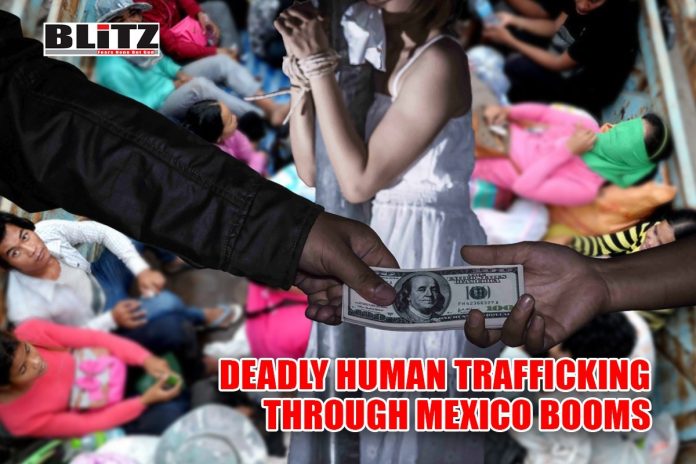In the hushed hills of Boqueron, a small region in the Dominican Republic, Kenia Castillo recalls the last moments with her son, Rafelín Martínez Castillo, before he embarked on a journey that would end in tragedy. Rafelín, a skilled craftsman, left behind his woodworking tools to pursue the promise of a better life in the United States. Little did he know that his quest would lead him into the heart of a deadly human trafficking network spanning across Mexico.
The story of Rafelín Martínez Castillo is just one among thousands of migrants who have fallen victim to the perilous journey through Mexico. Like many others, he entrusted his fate to smugglers who promised safe passage across borders. But on December 9, 2021, tragedy struck when the trailer truck carrying Rafelín and 168 other migrants overturned on a highway in Chiapas, claiming 56 lives and leaving 113 wounded. The gruesome images of bodies strewn across the highway shocked the world and exposed the dark underbelly of human trafficking.
Behind this tragedy lies a disturbing trend: the increasing use of cargo vehicles by cartels to transport migrants through Mexico. As the Mexican government cracks down on unauthorized migration, cartels have seized control of the smuggling business, pushing migrants into even riskier routes. The lucrative nature of human trafficking, estimated to generate billions of dollars annually for cartels, has emboldened criminal organizations to operate with impunity, exploiting vulnerable migrants for profit.
The journey through Mexico is fraught with danger at every turn. From suffocating heat and lack of oxygen inside overcrowded trailers to deadly accidents on treacherous highways, migrants face unimaginable hardships. Despite the risks, many are driven by desperation, willing to endure anything in search of a better future for themselves and their families.
The plight of migrants is exacerbated by the complicity of government agencies and the trucking industry. Despite regulations meant to prevent the illegal transport of migrants, organized crime groups operate with impunity, evading detection as they exploit the vulnerabilities of the system. The collaboration between smugglers and drivers, often coerced under threats of violence, further perpetuates the cycle of exploitation.
For survivors like Yanira Chávez, the trauma of the journey lingers long after reaching their destination. Forced into a stifling trailer truck with her young children, Yanira endured unimaginable conditions before being held captive in Mexico and eventually crossing the Rio Grande to seek asylum in the United States. Her harrowing experience serves as a stark reminder of the human cost of migration and the ruthlessness of those who profit from human suffering.
Despite the scale of the crisis, justice remains elusive for victims and their families. With few convictions for human trafficking and widespread impunity, migrants are left vulnerable to further exploitation and abuse. The failure of governments to hold perpetrators accountable only perpetuates the cycle of violence and injustice.
In the wake of tragedies like the Chiapas accident, calls for action have gone unanswered, leaving grieving families to grapple with the aftermath alone. Promises of investigations and reforms have yielded little results, as bureaucratic inertia and political maneuvering stifle efforts to address the root causes of human trafficking.
As the global community grapples with the complex realities of migration and human rights, the stories of Rafelín Martínez Castillo, Yanira Chávez, and countless others serve as a sobering reminder of the urgent need for action. From strengthening legal protections for migrants to dismantling criminal networks, addressing the root causes of human trafficking requires a concerted effort from governments, civil society, and the international community.
In the face of overwhelming challenges, there is hope in the resilience of migrants and their unwavering determination to seek a better life. Their stories, though marked by tragedy, are a testament to the human spirit and the enduring quest for freedom, dignity, and justice. As we confront the realities of human trafficking, let us not forget the individuals behind the headlines and the urgent imperative to uphold their rights and protect their lives.
According to the International Consortium of Investigative Journalists (ICIJ), large numbers of Central Americans have been passing through Mexico to reach the US since at least the 1980s, fleeing civil wars or attracted by American companies’ demand for cheap labor. That migration continued in the late 1990s, when thousands left their countries after the devastation caused by Hurricane Mitch in 1998. Other waves followed, driven by economic crises, climate change, violence and political upheaval. Around 2010 a new trend emerged: Thousands of Asian and African migrants arrived in the south of Mexico after traversing the Americas en route to the US.
To contain the flow, the US and Mexico have beefed up the presence of law enforcement at their borders. With funding from the US, Mexico increased deportations, sending hundreds of thousands of people back to their countries and even deporting more than the United States has in particular years.
Mexico became what experts call “a vertical border”, explained Gretchen Kuhner, director of the Institute for Women in Migration, a nonprofit advocacy group. This means that immigration inspections aren’t happening only at entry points at borders, airports and seaports, Kuhner said. Instead, stops and searches can happen anywhere. Soldiers and immigration agents began stopping people in parks and other public areas as far back as nearly 10 years ago, boarding buses and pulling over vehicles to catch undocumented migrants. (In 2022 the Mexican Supreme Court declared this practice unconstitutional after three Indigenous siblings who were racially profiled sued, but that hasn’t stopped the practice).




